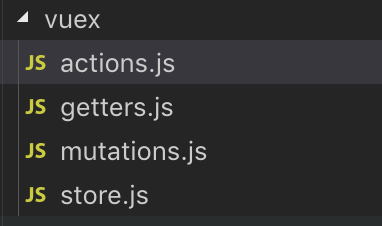vue项目--vuex状态管理器
本文取之官网和其他文章结合自己的理解用简单化的语言表达。用于自己的笔记记录,也希望能帮到其他小伙伴理解,学习更多的前端知识。
-
Vuex 是什么?
Vuex 是一个专为 Vue.js 应用程序开发的状态管理模式。它采用集中式存储管理应用的所有组件的状态,并以相应的规则保证状态以一种可预测的方式发生变化。
官方文档: https://vuex.vuejs.org/zh/
简单的说,这个vuex可以用于存储数据的状态。例如:
我的个人信息是否完善的这个状态,可以存储在vuex中,在不同的页面可以读取、更改这个状态。这样就不用页面之间传参等方式。
当然也可以存储一些信息,例如数组、对象、字符串都可以,类似前端的数据库。如果只有这个特点的话,有的小伙伴会有疑问,那本地存储也可以做到的,现在我们就看一下vuex与本地存储的区别。
1.区别:vuex存储在内存,localstorage(本地存储)则以文件的方式存储在本地,永久保存;sessionstorage( 会话存储 ) ,临时保存。localStorage和sessionStorage只能存储字符串类型,对于复杂的对象可以使用ECMAScript提供的JSON对象的stringify和parse来处理
2.应用场景:vuex用于组件之间的传值,localstorage,sessionstorage则主要用于不同页面之间的传值。
3.永久性:当刷新页面(这里的刷新页面指的是 --> F5刷新,属于清除内存了)时vuex存储的值会丢失,sessionstorage页面关闭后就清除掉了,localstorage不会。
注:很多同学觉得用localstorage可以代替vuex, 对于不变的数据确实可以,但是当两个组件共用一个数据源(对象或数组)时,如果其中一个组件改变了该数据源,希望另一个组件响应该变化时,localstorage,sessionstorage无法做到,原因就是区别1
原始网址:https://blog.csdn.net/sinat_36729274/article/details/87433615
- vuex安装
安装命令行:npm install vuex --save

安装成功后,使用命令行:npm run dev 运行项目。接下来会在项目中使用vuex,首先,在src文件夹下新建一个名为store的文件夹,在store文件夹下新建index.js文件,index.js文件的内容分为:
import Vue from 'vue' // 引入vue
import Vuex from 'vuex' // 引入vuex
// 使用vuex
Vue.use(Vuex)
// 创建vuex实例
const store = new Vuex.Store({
})
export default store
然后在main.js文件中引入store文件夹下的index.js文件。main.js文件中内容如下:
import Vue from 'vue'
import App from './App'
import router from './router'
import store from './store' // ------------ 引入store文件夹下面的index.js
Vue.config.productionTip = false
/* eslint-disable no-new */
new Vue({
el: '#app',
store, // -------------- 将store 添加到vue的实例中
router,
components: { App },
template: '<App/>'
})
这样我们就在项目中引入vuex了,那怎么使用vuex呢?
vuex的核心概念是以下几个:
-
- State
- Getter
- Mutation
- Action
- Module
下面是具体来讲一下vuex核心概念的使用方法吧。
- State
Vuex 使用单一状态树——是的,用一个对象就包含了全部的应用层级状态。至此它便作为一个“唯一数据源 (SSOT)”而存在。这也意味着,每个应用将仅仅包含一个 store 实例。单一状态树让我们能够直接地定位任一特定的状态片段,在调试的过程中也能轻易地取得整个当前应用状态的快照。
以上是官网的说法,我的理解就是在state中声明变量,可以在全部页面都可以使用state中的变量。
现在,我们开始新建和使用state,在store文件夹下面新建state文件夹,state文件夹下面新建index.js文件,index.js文件内容如下:
const state = {
name: 'weish',
age: 22,
todos: [
{ id: 1, text: '1111', done: true },
{ id: 2, text: '2222', done: false }
]
};
export default state;
然后将state引入到store中,所以在store文件夹下的index.js内容如下:
import Vue from 'vue' // 引入vue
import Vuex from 'vuex' // 引入vuex
import state from './state' // ---------引入state
// 使用vuex
Vue.use(Vuex)
// 创建vuex实例
const store = new Vuex.Store({
state // ---------将state添加到实例中
})
export default store
做完上面state中的声明与store中的引入,我们就可以在页面中使用state中的变量了。
HelloWorld.vue内容如下:
<template>
<div class="hello">
<h1>{{ msg }}</h1>
<h2>state:方法一:{{this.$store.state.age}}</h2>
<h2>state:方法二:{{age2}}</h2>
</div>
</template>
<script>
export default {
name: 'HelloWorld',
data () {
return {
msg: 'Welcome to Your Vue.js App'
}
},
computed:{
age2(){
return this.$store.state.age
}
}
}
</script>
<!-- Add "scoped" attribute to limit CSS to this component only -->
<style scoped>
</style>
使用辅助函数mapState时,HelloWorld.vue内容如下:
<template>
<div class="hello">
<h1>{{ msg }}</h1>
<h2>state:方法一:{{this.$store.state.age}}</h2>
<h2>state:方法二:{{age2}}</h2>
<h2>state:方法三:{{age3}}</h2>
<h2>state:方法四:{{age4}}</h2>
</div>
</template>
<script>
// 辅助函数为 Vuex.mapState
import { mapState } from 'vuex'
export default {
name: 'HelloWorld',
data () {
return {
msg: 'Welcome to Your Vue.js App'
}
},
computed: mapState({
age2: 'age', //方法2
age3: (state) => state.age, // 方法3
age4:function () {
return this.$store.state.age // 普通函数的使用store的方式,方法4
}
})
//没有使用mapState时,普通函数的写法
// computed:{
// age5(){
// return this.$store.state.age //方法5
// },
// ...mapState(['name','age']) // 方法6
// }
}
</script>
<!-- Add "scoped" attribute to limit CSS to this component only -->
<style scoped>
</style>
页面效果如下:

- Getter
有时候我们需要从 store 中的 state 中派生出一些状态,例如对列表进行过滤并计数:
computed: {
doneTodosCount () {
return this.$store.state.todos.filter(todo => todo.done).length
}
}
如果有多个组件需要用到此属性,我们要么复制这个函数,或者抽取到一个共享函数然后在多处导入它——无论哪种方式都不是很理想。
Vuex 允许我们在 store 中定义“getter”(可以认为是 store 的计算属性)。就像计算属性一样,getter 的返回值会根据它的依赖被缓存起来,且只有当它的依赖值发生了改变才会被重新计算。
在store文件夹下新建getters文件夹,在getters文件夹下新建index.js,内容如下:
export const doneTodosCount = (state) => {
return state.todos.filter(todo => todo.done).length;
}
在store文件夹下index.js中引入getters
import Vue from 'vue' // 引入vue
import Vuex from 'vuex' // 引入vuex
import state from './state'
import * as getters from './getters' // ---------引入
// 使用vuex
Vue.use(Vuex)
// 创建vuex实例
const store = new Vuex.Store({
state,
getters // --------添加
})
export default store
可以通过属性访问:store.getters.doneTodosCount
<template>
<div class="hello">
<h1>{{ msg }}</h1>
<h2>getters: {{Count}}</h2>
</div>
</template>
<script>
export default {
name: 'HelloWorld',
data () {
return {
msg: 'Welcome to Your Vue.js App'
}
},
computed:{
Count() {
return this.$store.getters.doneTodosCount // -------1
}
}
}
</script>
<!-- Add "scoped" attribute to limit CSS to this component only -->
<style scoped>
</style>
页面效果如下:

使用辅助函数mapGetters,内容如下:
<template>
<div class="hello">
<h1>{{ msg }}</h1>
<h2>getters: {{Count}}</h2>
<h2>getters:mapGetters {{doneTodosCount}}</h2> // -----------页面中{{doneTodoCount}}
</div>
</template>
<script>
// 在单独构建的版本中辅助函数为 Vuex.mapState 和mapGetter
import { mapState,mapGetters } from 'vuex' // -----引入mapGetters
export default {
name: 'HelloWorld',
data () {
return {
msg: 'Welcome to Your Vue.js App'
}
},
computed:{
age(){
return this.$store.state.age
},
...mapState(['name','age','todos']),
...mapGetters(['doneTodosCount']), //-----------在computed使用mapGetter
Count() {
return this.$store.getters.doneTodosCount
}
}
}
</script>
<!-- Add "scoped" attribute to limit CSS to this component only -->
<style scoped>
</style>
- Mutation
更改 Vuex 的 store 中的状态的唯一方法是提交 mutation。mutations必须是同步函数。
在store文件夹下新增mutations文件夹,在mutations文件夹下新增index.js,内容如下:
export const CACHE_AGE = (state, param) => { // 当提交格式是简单数据格式,例如:123,'123'
state.age += param;
}
export const newName = (state,payload) => { // 当提交格式是对象格式
state.name = payload.newName
}
在store文件夹下index.js中引入mutations
import Vue from 'vue' // 引入vue
import Vuex from 'vuex' // 引入vuex
import state from './state'
import * as getters from './getters'
import * as mutations from './mutations' // -----------引入mutations
// 使用vuex
Vue.use(Vuex)
// 创建vuex实例
const store = new Vuex.Store({
state,
getters,
mutations // ---------添加到实例
})
export default store
在页面中使用mutations修改state中age
<template>
<div class="hello">
<h1>{{ msg }}</h1>
<h2>state:方法一:{{this.$store.state.age}}</h2>
<h2>getters: {{Count}}</h2>
<h2>getters:mapGetters {{doneTodosCount}}</h2>
<div><button @click="plus()">点我age加2</button></div>
<h2>{{name}}</h2>
<div><button @click="changeName()">点我name修改为Alise</button></div>
</div>
</template>
<script>
// 在单独构建的版本中辅助函数为 Vuex.mapState
import { mapState,mapGetters } from 'vuex'
export default {
name: 'HelloWorld',
data () {
return {
msg: 'Welcome to Your Vue.js App'
}
},
computed:{
age(){
return this.$store.state.age
},
...mapState(['name','age','todos']),
...mapGetters(['doneTodosCount']),
Count() {
return this.$store.getters.doneTodosCount
}
},
methods:{
plus(){
this.$store.commit('CACHE_AGE', 2)
},
changeName(){
// this.$store.commit({type:'newName',newName:'Alise'}) //--------------对象风格提交格式 方法一
this.$store.commit('newName',{newName:'Alise'}) // -------------对象风格提交格式 方法二
}
}
}
</script>
-
- 使用常量替代Mutation事件类型
把这些常量放在单独的文件中可以让你的代码合作者对整个 app 包含的 mutation 一目了然。用不用常量取决于你——在需要多人协作的大型项目中,这会很有帮助。但如果你不喜欢,你完全可以不这样做。
在mutations文件夹下面新建mutation-types.js,内容如下:
export const CACHE_NAME_TYPE = 'CACHE_NAME_TYPE'
mutations文件夹下index.js,内容如下:
import { CACHE_NAME_TYPE } from './mutation-types'
const mutations = {
[CACHE_NAME_TYPE](state,payload){
state.name = payload.newName
}
}
export default mutations
// ps:如果mutation部分写成这种格式,那么在store文件夹下的index.js中引入mutations的方式需要修改写成
// import mutations from './mutations'
// 而不是 import * as mutations from './mutations'
在页面中使用mapMutations辅助函数:
<template>
<div class="hello">
<h1>{{ msg }}</h1
<h2>state:name:{{name}}</h2>
<div><button @click="changeName()">点我store的名字变成alise</button></div>
<div><button @click="changeName1()">点我store的名字变成Mark</button></div>
</div>
</template>
<script>
// 在单独构建的版本中辅助函数为 Vuex.mapState
import { mapState,mapGetters,mapMutations } from 'vuex' // ------引入mapMutation
export default {
name: 'HelloWorld',
data () {
return {
msg: 'Welcome to Your Vue.js App'
}
},
computed:{
...mapState(['name','age','todos']),
...mapGetters(['doneTodosCount'])
},
methods:{
...mapMutations(['CACHE_NAME']), // -------------在methods中映射,将this.CACHE_NAME()映射为this.$store.commit('CACHE_NAME')
changeName(){
this.$store.commit('newName',{newName:'Alise'})
},
changeName1(){
this.CACHE_NAME({newName:'MARK'}) // -------使用
}
}
}
</script>
- Action
action类似mutation,不同之处在于:
-
- action提交的mutation,而不是直接改变的状态
- action可以包含任一异步操作
在store文件夹下新建actions文件夹,actions文件夹下新建index.js,内容如下:
export const setName = ({ commit }, param) => {
commit('CACHE_NAME', param)
}
在store文件夹下的index.js中引入actions

就可以在页面中使用actions了,在页面中调用actions的方法是:this.$store.dispatch('setName',{newName:'Tom'}),具体代码如下:
<template>
<div class="hello">
<h1>{{ msg }}</h1
<h2>state:name:{{name}}</h2>
<div><button @click="changeName()">点我store的名字变成alise</button></div>
<div><button @click="changeName1()">点我store的名字变成Mark</button></div>
<div><button @click="changeName2()">点我store的名字通过actions方式变成Tom</button></div>
</div>
</template>
<script>
import { mapState,mapGetters,mapMutations } from 'vuex'
export default {
name: 'HelloWorld',
data () {
return {
msg: 'Welcome to Your Vue.js App'
}
},
computed:{
...mapState(['name','age','todos']),
...mapGetters(['doneTodosCount'])
},
methods:{
...mapMutations(['CACHE_NAME']),
changeName(){
this.$store.commit('newName',{newName:'Alise'})
},
changeName1(){
this.CACHE_NAME({newName:'MARK'})
},
changeName2(){
this.$store.dispatch('setName',{newName:'Tom'})
}
}
}
</script>
使用mapActions辅助函数:
<template>
<div class="hello">
<h1>{{ msg }}</h1
<h2>state:name:{{name}}</h2>
<div><button @click="changeName()">点我store的名字变成alise</button></div>
<div><button @click="changeName1()">点我store的名字变成Mark</button></div>
<div><button @click="changeName2()">点我store的名字通过actions方式变成Tom</button></div>
</div>
</template>
<script>
import { mapState,mapGetters,mapMutations,mapActions } from 'vuex' // ------------添加mapActions
export default {
name: 'HelloWorld',
data () {
return {
msg: 'Welcome to Your Vue.js App'
}
},
computed:{
...mapState(['name','age','todos']),
...mapGetters(['doneTodosCount'])
},
methods:{
...mapMutations(['CACHE_NAME']),
...mapActions(['setName']), // 修改二:在methods中添加...mapActions
changeName(){
this.$store.commit('newName',{newName:'Alise'})
},
changeName1(){
this.CACHE_NAME({newName:'MARK'})
},
changeName2(){
// this.$store.dispatch('setName',{newName:'Tom'})
this.setName({newName:'Tom1111'}) // 修改三:使用this.setName提交修改mutation
}
}
}
</script>
actions中通常是异步操作,可以组合使用action,以处理更复杂的流程。可查看官网例子组合action,官网地址:https://vuex.vuejs.org/zh/guide/actions.html
- Modules
由于使用单一状态树,应用的所有状态会集中到一个比较大的对象。当应用变得非常复杂时,store 对象就有可能变得相当臃肿。
为了解决以上问题,Vuex 允许我们将 store 分割成模块(module)。每个模块拥有自己的 state、mutation、action、getter、甚至是嵌套子模块——从上至下进行同样方式的分割。官方地址:https://vuex.vuejs.org/zh/guide/modules.html。
在store文件夹下,新建modules文件夹,在modules文件夹下面新建moduleA.js文件,内容如下:
const moduleA = {
state: { count: 0 },
mutations: {
increment (state,num) {
// 这里的 `state` 对象是模块的局部状态
state.count += num
}
},
getters: {
sumWithRootCount (state, getters, rootState) {
return state.count + rootState.age
}
},
actions:{
incrementIfOddOnRootSum ({ state, commit, rootState },param) {
console.log(state,rootState,param) // state :局部state传入值,如:{count:0},rootState:根元素state传入值,param:外部传入参
commit('increment',param.num)
}
}
}
export default moduleA
在store文件夹下index.js文件中,引入moduleA.js,内容如下:
import Vue from 'vue' // 引入vue
import Vuex from 'vuex' // 引入vuex
import state from './state'
import * as getters from './getters'
import * as mutations from './mutations'
import * as actions from './actions'
// import mutations from './mutations'
// moudules
import mouduleA from './modules/moduleA' // --------引入moduleA
// 使用vuex
Vue.use(Vuex)
// 创建vuex实例
const store = new Vuex.Store({
state,
getters,
mutations,
actions,
modules:{
a:mouduleA // -----------实例化
}
})
export default store
在页面中使用moduleA,helloword.vue内容如下:
<template>
<div class="hello">
<h1>{{ msg }}</h1>
<h2>mouduleA--count:{{a.count}}</h2> // 使用mapState在页面中显示,也可直接写 this.$store.state.a.count
<h2>moduleA--sumWithRootCount:{{sumWithRootCount}}</h2> // 使用mapGetters
<div><button @click="changeCount()">点我ModuleA的Count+某个数</button></div>
</div>
</template>
<script>
// 在单独构建的版本中辅助函数为 Vuex.mapState
import { mapState,mapGetters,mapMutations,mapActions } from 'vuex' // -------引入mapState,mapGetters,mapMutations,mapActions
export default {
name: 'HelloWorld',
data () {
return {
msg: 'Welcome to Your Vue.js App'
}
},
computed:{
...mapState(['a']), // 在computed中 --------------使用mapState
...mapGetters(['sumWithRootCount']), // computed中-----------使用mapGetters
Count() {
return this.$store.getters.doneTodosCount
}
},
methods:{
...mapMutations(['increment']), // 在methods中-----------使用mapMutations
...mapActions(['incrementIfOddOnRootSum']), // 在methods中---------使用mapActions
changeCount(){
// this.$store.commit('increment',11) // ------------一般方法 mutation 修改moduleA中state中的值
// this.$store.dispatch('incrementIfOddOnRootSum',{num:12}) // --------------一般方法 action 提交mutation
// this.increment(12) // ----------使用mapMutations 修改moduleA中state的值
this.incrementIfOddOnRootSum({num:10}) // ------------使用mapActions 提交mutations
}
}
}
</script>
<!-- Add "scoped" attribute to limit CSS to this component only -->
<style scoped>
</style>
- store文件夹目录
store文件夹下,经过上述的关于核心概念的介绍,新建了actions、getters、state、mutations和modules五个文件夹,除modules文件夹下面是moduleA.js之外,其他下面都是index.js文件。第一图是store文件夹下的目录,中图是展开后,当然也可以根据自己的习惯管理文件。例如第三图。



ok,上述代码均经过本人测试,如果有问题,欢迎留言。




 浙公网安备 33010602011771号
浙公网安备 33010602011771号